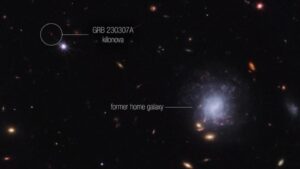
One of the awesome things about growing older as an astronomer is you get to see the weird stuff no one understood in your youth become the everyday normal of your middle age.
While we still don’t understand things like dark matter or the accelerating expansion of our universe, I’m really enjoying the evolution of our understanding of gamma ray bursts. First discovered in the 1960s, the only things we knew for certain when I started in astronomy were some bursts lasted up to several minutes, while others lasted only seconds or less. While that is information… it wasn’t satisfying information. Over the decades, we’ve come to learn that Gamma Ray Bursts are triggered by at least 3 different phenomena, including the merger of Neutron Stars.
These wild events light up detectors of all kinds, with everything from gravitational waves to light of most colors all slamming into our world at once. These kinds of mergers had been theorized for a long time, but it was only in 2017 that one was finally observed, allowing researchers to confirm these mergers are one of the largest producers of heavy elements like gold.
In March of this year, 2023, a 200 second long gamma ray burst called attention to the merger of two neutron stars. As the massive yet tiny dead stellar cores came together, they created a hot, high-density environment where atomic cores, neutrons, and fragmenting atoms could all slam together. This event was spotted by NASA Fermi Gamma-Ray Space Telescope, which – along with collaboration ground-based telescopes- measured its location with an accuracy sufficient to allow controllers to point the JWST at the explosion. In infra-red light, they made out a distant pinprick of light, called a kilonova, in the outskirts of a spiral galaxy 120,000 light years away.
Using a spectrometer, they were able to split the kilonova’s light into a rainbow and look for the specific dips and peaks that indicate what elements are present. For the first time ever they identified features associated with the atom tellurium. On Earth, this atom is more rare than platinum, and is necessary in a number of manufacturing processes, including the tinting of glass and ceramics, as a catalyst in oil refining, and in the construction of solar cells.
This means, an ingredient in our planet’s modern technology is born in the death of two stars.
We are after all, nothing more than star stuff. It’s just wild what has to happen to create the diversity of atoms needed to create our wild world.
